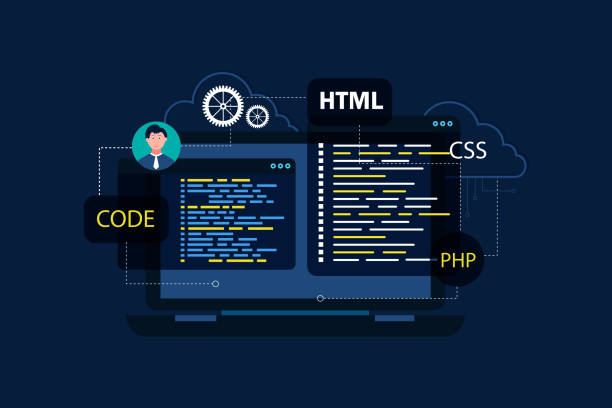Why is Secure Website Design Crucial? Understanding the Fundamental Importance of Web Security

In today’s world, where digital boundaries have become an inseparable part of daily life and businesses, the issue of #web_security and #data_protection holds special importance.
Cybersecurity is no longer a luxury option, but a fundamental necessity for every website.
Secure website design not only protects sensitive user information but also builds their trust and contributes to the long-term sustainability of the business.
A successful cyberattack can lead to brand reputation damage, significant financial losses, loss of customer data, and even business collapse.
This is particularly crucial for online stores, banks, and any platform dealing with personal or financial information.
Therefore, every web development project must be built on the solid principles of secure website design from its initial stages.
Focusing on website security and vulnerability prevention is no less important than focusing on its aesthetic appeal or functionality.
This proactive approach significantly reduces potential costs resulting from security breaches and ensures the long-term sustainability of your digital platform.
A deep understanding of web threats and vulnerabilities is the first step on the path to secure website design.
This article, presented in an educational and analytical manner, will familiarize you with various aspects of this vital topic.
Discussions ranging from technical complexities to simpler and more understandable solutions are all designed to increase your awareness and capabilities in the field of web protection.
The main goal is to provide a comprehensive framework for website security principles that not only protects you against common attacks but also gives you insight into dealing with future threats and prevents serious crises.
Imagine you have a healthcare system or an online educational platform that processes thousands of sensitive data daily; the slightest security breach can lead to loss of user privacy, identity misuse, and ultimately, the complete destruction of your organizational reputation.
Secure website design acts as a protective shield here.
This not only includes clean and optimized coding but also proper server configuration, use of secure protocols, and precise access management.
This is a specialized topic that requires knowledge and a systematic approach.
The importance of this issue is such that many companies and organizations make huge investments in secure web development to protect their digital assets and reassure their users.
This article aims to engage your mind with web security challenges by providing thought-provoking and analytical content, helping you make the best decisions for your secure website design project and protect your platform against increasing threats.
Dreaming of a thriving online store but don’t know where to start?
RasaWeb is your comprehensive e-commerce website design solution.
✅ Attractive and user-friendly design
✅ Increased sales and revenue⚡ Get free consultation
Common Web Vulnerabilities and Countermeasures

On the path to secure website design, a precise understanding of common #vulnerabilities and #cyber_attacks is the first and crucial step.
Hackers are constantly looking for weaknesses in websites to gain access to sensitive information, disrupt services, or take control of the system.
The OWASP Top 10 list is a vital educational and specialized resource that introduces the most common and critical web security vulnerabilities and is used as a global standard.
Among these vulnerabilities are SQL Injection, Cross-Site Scripting (XSS), Broken Authentication, and Insecure Deserialization.
Each of these attacks can have devastating consequences for the website and its users, from identity theft to complete data loss.
For example, in an SQL Injection attack, the attacker can gain access to the database by injecting malicious SQL code through website input forms, and extract, modify, or even delete confidential information.
This vulnerability arises due to the lack of proper input validation and can be easily exploited by hackers.
On the other hand, XSS allows an attacker to inject malicious JavaScript code into web pages and execute it in the victim’s browser.
This attack can lead to cookie theft, website defacement, redirection of users to fake sites (Phishing), or even execution of arbitrary commands in the victim’s browser.
These explanations are illustrative to show the importance of website security at every stage of development, from design to implementation and maintenance, and to emphasize the need for continuous vigilance.
For secure website design, developers must be specialized in these vulnerabilities and implement the necessary measures to prevent them.
Using modern frameworks with built-in security features, adhering to secure coding principles (such as input and output validation), and performing regular security tests (like penetration testing) are among the countermeasures against these threats.
Furthermore, continuous updating of software and libraries used in the project also plays a vital role in web protection; as older versions often have known vulnerabilities that are easily exploitable.
Ignoring these principles can turn your website into an easy target for attackers and render your efforts in secure web development fruitless.
Therefore, awareness and action will be your guidance on this path, and special attention should always be paid to it.
Secure Coding Principles and Vulnerability Prevention

The heart of secure website design lies in adhering to #secure_coding principles and preventing common weaknesses.
Developers play a pivotal role in this area; as many vulnerabilities stem from programming errors or a failure to adhere to best practices during the development process.
One of the most important principles is Input Validation.
All data received from the user, whether in forms, URL parameters, headers, or cookies, must be carefully checked, filtered, and sanitized.
This action prevents attacks such as SQL Injection, XSS, and Directory Traversal, which were mentioned earlier.
Using parameterized functions for database queries, and Output Encoding for displaying user input data on web pages, is essential.
This section is presented in an educational and specialized manner to assist you on the path of secure web development.
In addition to input validation, proper Error Handling is also of great importance.
Generic and non-transparent error messages should be displayed instead of precise technical details that could be useful to attackers.
Session Management must also be implemented correctly and carefully; secure tokens with limited expiration times should be used to prevent attacks such as Session Hijacking.
Preventing the disclosure of sensitive information (such as API keys, passwords, or file paths) in source code, using up-to-date and well-known libraries and frameworks with strong security support, and also Separation of Concerns and applying the Principle of Least Privilege in software architecture, are other key approaches in website security.
These items are considered an important part of practical guidelines for secure website design.
For better understanding, the table below shows some of the key principles of secure coding and their applications.
These principles are essential for anyone involved in website security design principles and should be continuously considered in the development process.
Implementing these principles not only helps improve security but also increases system stability and reliability.
| Security Principle | Description | Example/Application |
|---|---|---|
| Input Validation | Checking, sanitizing, and filtering all user inputs before processing | Prevention of SQL Injection, XSS, and Path Traversal |
| Output Encoding | Converting special characters in output to a secure form for display | Prevention of XSS and HTML Injection attacks |
| Error Handling | Displaying generic and vague error messages instead of technical details | Prevention of sensitive system information disclosure (e.g., file paths) |
| Session Management | Using secure tokens, expiration, and invalidation of sessions after logout | Prevention of Session Hijacking and Session Fixation |
| Strong Authentication | Requirement for complex passwords, Multi-Factor Authentication (MFA) | Protection against Brute Force and Credential Stuffing attacks |
This is only a part of the necessary approaches for secure website design, but adhering to these very principles can make a big difference in your website’s overall security and provide a strong foundation for protecting it against common threats.
The Role of SSL/TLS in Secure Website Design and Data Encryption

One of the pillars of #secure_website_design and data encryption is the use of #SSL_TLS and #HTTPS protocols.
These protocols ensure that communication between the user’s browser and the website server is encrypted and protected against eavesdropping, tampering, or identity spoofing.
In the past, many websites used the HTTP protocol, which transmitted data as plain text, making them vulnerable to Man-in-the-Middle (MitM) attacks.
However, with the widespread adoption of HTTPS, this risk has been significantly reduced and has become an industry standard.
This section, presented in an educational and explanatory manner, discusses the importance and mechanisms of these protocols.
HTTPS (Hypertext Transfer Protocol Secure) is essentially HTTP combined with the security layers of TLS (Transport Layer Security) or SSL (Secure Sockets Layer).
TLS is the more secure and updated successor to SSL, although the term SSL is still widely used.
When you visit a website with HTTPS, your browser checks the site’s SSL/TLS certificate to ensure its authenticity and validity.
This certificate is issued by a Certificate Authority (CA) and contains information about the website’s identity.
If the certificate is valid, an encrypted connection is established between the browser and the server, and all exchanged data, including login information, financial transactions, personal data, and other communications, are transmitted in an encrypted form, eliminating the possibility of being read by unauthorized individuals.
This is a vital part of website security principles that cannot be overlooked.
Implementing HTTPS is not only essential for protecting user data but also has a positive impact on the website’s SEO ranking.
Search engines like Google prefer HTTPS websites over HTTP websites and give them a higher ranking in search results.
This not only helps increase user trust and encourages them to interact with the site but also demonstrates your commitment to secure website design and adherence to security standards.
To ensure website security, all website pages, including resources like images, CSS files, and JavaScript, must be loaded via HTTPS.
This process, known as Mixed Content, can generate security warnings in the browser and undermine the site’s security credibility.
Therefore, attention to detail in secure web development and complete transition to HTTPS is very important.
Tired of losing customers due to poor e-commerce website design? With RasaWeb, solve this problem forever!
✅ Increase sales and visitor-to-customer conversion rate
✅ Smooth and engaging user experience for your customers⚡ Get free consultation
User Authentication and Authorization: The Cornerstone of Security

In secure website design, #user_authentication and #authorization are two fundamental pillars for access control and protection of sensitive system resources.
Authentication deals with the process of verifying a user’s identity (e.g., via username and password), while Authorization determines what resources an authenticated user can access and what operations they can perform.
Ignoring strong standards in these two areas can lead to unauthorized access, increased attack surface, and serious system attacks.
This is a specialized yet guiding topic that must be implemented with great care and by considering best practices to ensure user and data security.
For authentication, using complex and unique passwords, requiring periodic password changes, and implementing Two-Factor Authentication (2FA) or Multi-Factor Authentication (MFA) mechanisms are strongly recommended.
Furthermore, encrypting (hashing) passwords with strong algorithms resistant to Brute Force and Rainbow Table attacks, such as Argon2 or bcrypt, and adding Salting for each password separately, is essential.
Never store passwords in plaintext.
In authorization, the Principle of Least Privilege should be followed; meaning that each user or role should be granted only the minimum necessary access to perform their tasks, and no more.
This approach significantly helps in website security against internal and external abuses.
Another important aspect in secure website design is proper Session Management.
Sessions (Session Tokens) must have a logical expiration time and should be quickly invalidated after user logout or a specified period of inactivity.
Using secure session tokens and storing them in a secure location (such as HttpOnly and Secure cookies) prevents session hijacking.
Failure to pay attention to these details can lead to Session Hijacking or Session Fixation attacks, which allow an attacker to take control of a legitimate user’s session.
Precise implementation of these mechanisms is crucial for web protection and ensuring that only authorized users have access to their resources.
This explanatory and practical section is your guide to implementing the strongest security systems in secure web development and ensures that accesses are properly managed.
Database Security: The Beating Heart of Secure Website Design

The database is the beating heart of every website and contains #sensitive_information of users and businesses.
Therefore, #database_security is of paramount importance in #secure_website_design.
Without proper database security, even the strongest security measures in other layers of the website will be useless and can lead to widespread data leaks.
SQL Injection attacks are one of the most common and destructive threats against databases, which can lead to information disclosure, data manipulation, deletion of vital information, or even full control of the database server.
This chapter, presented in a specialized and educational manner, addresses methods to counter these threats and enhance database security.
To prevent SQL Injection attacks, using Prepared Statements and Parameterized Queries is vital.
These methods ensure that user inputs are processed as data and are never interpreted as part of the SQL code, thereby preventing the injection of malicious code.
Furthermore, applying the Principle of Least Privilege at the database level means granting only the minimum necessary access to the website’s user account for connecting to the database (e.g., only SELECT, INSERT, UPDATE, and DELETE accesses if needed, and not administrative accesses).
This minimizes the risk of damage from a potential breach.
Encrypting sensitive data at rest (Data at Rest Encryption), such as credit card information, national identification numbers, or passwords, provides an additional layer of security and prevents their disclosure in case of unauthorized access to database files.
In addition to coding measures, proper database server configuration also plays a key role in secure website design.
This includes regular updates of database software, disabling unnecessary ports and services, and using a firewall to restrict database access only from authorized sources.
Continuous monitoring of database logs to identify suspicious activities and intrusion attempts is also of high importance.
Regular and automated backup of the database and storing them in a secure and separate location (off the main server) is an essential component of web protection and data recovery in case of disaster.
These comprehensive measures strengthen your approach to secure web development and protect your digital assets.
Finally, website security principles regarding databases must be an integral part of your overall security strategy and should be continuously reviewed and improved.
Server and Infrastructure Security: Beyond Code

One of the extensive dimensions of #secure_website_design, beyond website code, is #server and #infrastructure security.
Even if your application code is flawless, a vulnerable server can become the main entry point for attackers and render all your security efforts ineffective.
Infrastructure security includes secure operating system configuration, firewall management, system access management, and regular software and hardware updates.
This section, presented in an analytical and explanatory manner, addresses the importance of this layer of security.
Server and network security is as vital and indispensable as secure coding for web protection.
The first step in secure website design at the server level is Server Hardening.
This includes removing unnecessary services and software that could be entry points for attacks, closing unused ports in the firewall, and configuring the firewall to restrict access to the minimum necessary level (Principle of Least Privilege).
The use of weak default usernames and passwords in operating systems and server software should be strictly avoided, and strong passwords and two-factor authentication should be used for administrative access.
Regular security updates of the operating system and all software installed on the server (such as web servers like Apache/Nginx, databases, and programming languages like PHP/Python) are essential for patching known vulnerabilities.
An unpatched vulnerability, even an old one, can be a gateway for attackers to enter your system and lead to full server control.
Additionally, SIEM (Security Information and Event Management) systems and continuous monitoring of server logs are vital for identifying suspicious activities, intrusion attempts, and security alerts.
These systems can automatically detect anomalous patterns and alert system administrators.
Furthermore, using network security solutions such as Intrusion Detection and Prevention Systems (IDS/IPS) can provide additional layers of defense and prevent common network attacks.
These collective measures ensure secure web development from various aspects and provide a secure environment for your website.
Below, the table illustrates some key measures to enhance server security, which align with website security design principles and should be regularly implemented and reviewed.
| Security Measure | Description | Purpose |
|---|---|---|
| Server Hardening | Removing unnecessary services, ports, and applications and disabling default users | Reducing attack surface and closing unauthorized intrusion paths |
| Regular Updates | Installing security patches for the operating system and all installed software | Fixing known vulnerabilities and protecting against new attacks |
| Firewall Configuration | Controlling and filtering incoming and outgoing traffic based on security policies | Preventing unauthorized access and controlling data flow |
| Access Management | Granting least privilege and necessary accesses to users and services | Reducing the risk of internal misuse and privilege escalation attacks |
| Log Monitoring | Continuous review of server and network events to identify anomalies | Early detection of attacks, intrusions, and suspicious activities |
These measures are essential for ensuring a secure and stable website design and should be integrated into your website’s security strategy.
Security Audits and Penetration Testing: A Proactive Approach

Even with adherence to the best practices of #secure_website_design in coding and server configuration, no website is completely immune to risk.
For this reason, conducting regular #security_audits and #penetration_testing as a preventative and proactive approach to website security is essential.
Penetration testing is a simulation of real cyberattacks performed by security specialists (Pentesters) to identify vulnerabilities before real attackers discover them.
This is a specialized and guiding approach that contributes to continuous improvement of system security and reveals hidden weaknesses.
Penetration testing can be performed in various ways, including Black-box testing, where the pentester has no knowledge of the website’s internal structure and attacks from the perspective of an external hacker; and White-box testing, where full access to source code, system architecture, and documentation is provided, allowing for a deeper examination.
The main goal of these tests is to find security weaknesses in web applications, network infrastructure, servers, databases, and even human processes.
A comprehensive penetration test report, including details of identified vulnerabilities, their risk level, and recommendations for remediation, provides a valuable roadmap for improving website security design principles and helps the development team systematically address weaknesses.
In addition to penetration testing, automated Vulnerability Scanning is also a useful tool for quickly identifying known vulnerabilities and misconfigurations.
Although these scans cannot replace manual and comprehensive penetration testing, they can be very effective for continuous monitoring and early detection of problems.
Periodic security audits, including reviewing configurations, security policies, operational procedures, and compliance with standards (such as GDPR or PCI DSS), are also an integral part of secure web development.
These processes not only help you stay aware of the latest threats but also assure you that your efforts towards web protection are on the right track and continuously improving.
Secure website design is a continuous process that requires ongoing evaluation and improvement, and security audits play a vital role in this cycle.
Does your company’s website perform as befits your brand? In today’s competitive world, your website is your most important online tool. RasaWeb, specializing in professional corporate website design, helps you to:
✅ Build customer credibility and trust
✅ Convert website visitors into customers
⚡ Get a free consultation!
Incident Response and Disaster Recovery: Planning for the Worst-Case Scenario

Despite all measures in #secure_website_design and full adherence to security principles, the occurrence of security incidents is an undeniable possibility.
#Incident_Response (IR) and #Disaster_Recovery (DR) are two vital programs that prepare your website and organization for the worst-case scenarios.
Having a well-documented, tested, and up-to-date plan to deal with security breaches can make the difference between a temporary disruption and a full-blown disaster, helping the business return to normal faster.
This section is explanatory and informative to highlight the importance of preparedness and assist you in developing these plans.
The incident response plan should include specific steps: detection of the incident through monitoring and alert systems, containment to prevent damage spread and isolate affected systems, eradication and removal of the root cause of the intrusion or security weakness, recovery of systems and data to normal state and ensuring complete cleanup of any malicious code, and finally lessons learned from the incident to prevent its recurrence in the future.
Clear and rapid communication with users, partners, and relevant entities (if necessary and in accordance with data protection laws) is also very important in this process and helps maintain trust.
The incident response team must be trained and prepared beforehand to act quickly and efficiently when needed.
The disaster recovery plan addresses ensuring business continuity after larger and more destructive events such as major hardware failure, natural disasters (flood, earthquake), or widespread cyberattacks (like ransomware attacks that cripple the entire system).
This includes having regular, automated, and reliable backups of all website data and configurations, stored in a secure and separate location (off the main server).
Also, the ability to quickly and effectively restore systems in a new environment (e.g., a backup server or alternative cloud environment) and periodically testing these plans to ensure their effectiveness in real-world conditions is essential.
Ignoring these aspects, even after spending significant time and money on secure web development, can render all efforts ineffective.
Web protection and website security design principles go beyond prevention; preparedness for the worst-case scenario is also an integral part of it.
This comprehensive approach helps you maintain your website security in all circumstances, regain user trust, and protect your business from irreparable damage.
The Future of Secure Website Design and New Trends

The world of #secure_website_design is constantly evolving.
With the emergence of new technologies and the evolution of attack methods, it is necessary for security specialists and developers to always stay abreast of #new_trends and #emerging_threats to protect websites against future challenges.
Artificial Intelligence (AI), Machine Learning (ML), Blockchain, and quantum computing present both new opportunities to enhance security and new challenges for secure web development.
This section, presented in an analytical and thought-provoking manner, addresses the future of web security and opens new horizons for readers.
Artificial intelligence and machine learning can be very effective in detecting suspicious patterns and predicting cyberattacks.
Intelligent SIEM systems are capable of analyzing vast amounts of log data and network traffic to identify anomalies that remain hidden from human eyes; including Zero-Day attacks that are not yet known.
On the other hand, attackers also use AI to develop more sophisticated attacks, more targeted phishing (Spear Phishing), and automated attacks.
Therefore, a secure website design must be capable of continuous adaptation and evolution.
Blockchain, with its capabilities such as decentralization, transparency, and data immutability, also holds great potential for enhancing data security, decentralized authentication, and identity management, but its widespread implementation in everyday web applications still faces challenges and requires further maturity.
Focus on data privacy, with the emergence and implementation of regulations like GDPR in Europe and CCPA in California, has become one of the most important aspects of website security design principles.
Websites must have full transparency regarding how user data is collected, stored, processed, and used, and give users more control over their personal information.
Zero Trust security, which considers no user, device, or service trustworthy by default, even within the network, and always requires authentication and authorization, is an approach that is gradually gaining widespread adoption.
This engaging yet serious perspective shows that web protection is a perpetual arms race, and website security should be considered a continuous and dynamic process.
Therefore, you should always strive to learn, research, and update your knowledge in the field of secure web development to protect websites against future security challenges.
Frequently Asked Questions
| Question | Answer |
|---|---|
| 1. What does secure website design mean? | Secure website design means creating a website that is resistant to cyberattacks and protects user and server information. |
| 2. Why is security important in website design? | To prevent data breaches, protect user privacy, maintain user trust, and prevent financial and reputational losses. |
| 3. What are the most common web vulnerabilities? | SQL Injection, Cross-Site Scripting (XSS), Cross-Site Request Forgery (CSRF), Broken Authentication, and Security Misconfiguration. |
| 4. How can SQL Injection be prevented? | By using Prepared Statements / Parameterized Queries, ORMs, and Input Validation. |
| 5. What is the role of HTTPS and SSL/TLS in website security? | HTTPS encrypts the communication between the user’s browser and the server using the SSL/TLS protocol, preventing eavesdropping and data tampering. |
| 6. What measures should be taken to prevent XSS attacks? | Input validation, Output Encoding to prevent malicious code execution, and using Content Security Policy (CSP). |
| 7. What does a strong password policy include? | Mandating long passwords, a combination of uppercase and lowercase letters, numbers, and special characters, and preventing reuse. |
| 8. How does Two-Factor Authentication (2FA) help security? | Even if the user’s password is compromised, the attacker cannot access the account without access to the second authentication factor (e.g., SMS code or app). |
| 9. What is a Web Application Firewall (WAF) and what is its use? | A WAF is a firewall that monitors and filters HTTP traffic between a web application and the Internet to prevent common web attacks such as SQL injection and XSS. |
| 10. Why are regular updates of software and libraries important? | Updates often include security patches to fix discovered vulnerabilities. Failure to update can expose the site to new attacks. |
And other services of RasaWeb Advertising Agency in the field of advertising
Smart Sales Automation: A combination of creativity and technology to increase click-through rates through SEO-driven content strategy.
Smart SEO: An innovative service for digital branding enhancement through user experience customization.
Smart Content Strategy: Designed for businesses seeking to increase sales through attractive UI design.
Smart Digital Branding: A combination of creativity and technology for online growth through attractive UI design.
Smart Advertising Campaign: A dedicated service for campaign management growth based on marketing automation.
And over hundreds of other services in the field of internet advertising, advertising consulting, and organizational solutions
Internet Advertising | Advertising Strategy | Advertorial
Resources
Security on Digiato
Web Security on Zoomit
Website Security Checklist on Rayanama
Website Security Tips on HostIran
? Looking to grow and be seen in the digital world? RasaWeb Afarin Digital Marketing Agency, relying on up-to-date knowledge and extensive experience in user-friendly website design and implementing effective online marketing strategies, is always ready to assist you on the path to achieving great success.
📍 Tehran, Mirdamad Street, next to Bank Markazi, Kazerun Jonoubi Alley, Ramin Alley No. 6




